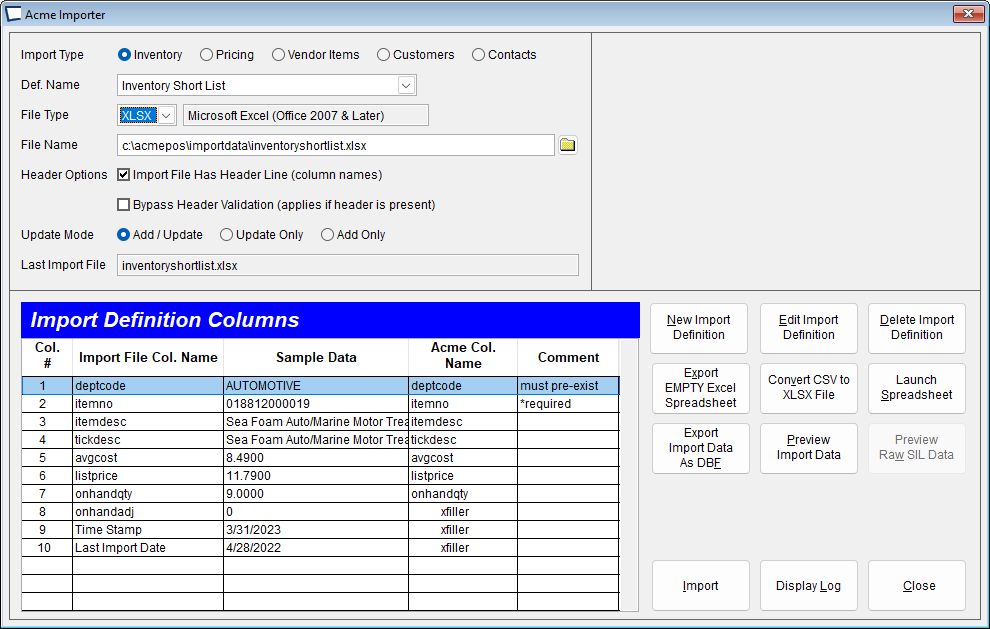Click >Maintenance >Acme Importer
Also see: Tips for Exporting Data from Your Old Point of Sale System

Import Types
1.Import Inventory Data -including list price, on hand quantities, on hand adjustments and more.
2.Import Pricing Data -quantity and customer specific pricing.
3.Import Vendor Data -including part numbers, catalog cost, min. quantity for suggested PO, etc.
4.Import Customer Data -name, address, phone, credit limit, etc. -creates one default contact per new customer.
5.Import Contact Data -additional contacts for existing customers.
Import File Type -Choose to import CSV, Excel or SIL file types.
If you choose to import Excel files you must have Excel 2007 or later installed. If you use Open Office or some other program for spreadsheet work you can save the output as CSV and import that into Acme.
TIP: If you have CSV either use the button to convert to XLSX or use Open Office for opening CSV files.
SIL is a file specification maintained by the UCC. Acme Point of Sale includes a SIL Interpreter that is invoked when you select to import SIL files. See Import SIL Inventory Files
Import Button
Acme will error check the import file and everything looks good, process the records according to your Add/Update selection. If problems occurred display the log file to determine proper action.
Record Update Mode
•Add/Update -updates existing records if found, and adds new records for items not already in Acme.
•Update Only -will not add new items. Useful if your vendor list includes more items then you sell or more than you want in your Acme.
•Add Records Only -Don't touch existing records, only add new ones.
Display Log Button
View the log to see what the Import button did and for help determining how to fix import problems, if any.
==
New Import Definition / Edit Import Definition / Delete Import Definition
Select an import file before trying to add or edit a definition. See "Edit Import Definitions" below.
Export Empty Spreadsheet
Use this if you wish to copy paste some data into a format you can readily import. The spreadsheet will be based on the current definition.
Convert CSV to XLSX
If you have Excel and like working with spreadsheets better than CSV's.
Launch Spreadsheet
Opens the sheet in Excel. Only works if Excel 2007 or newer is installed on your computer.
Preview Import Data
Pop up list you can sort and browse.
Export (the) Import Data as DBF
Used for troubleshooting. Also used for data manipulation by professional services during intial data migration from other systems.
==
Edit Import Definitions
"Import Definitions" map the columns in your file to their proper place in Acme. Columns of data that are required or must pre-exist are noted as part of the column name and visible when building definitions.

You are encouraged to use column headings that match the field names in Acme. Its easy to do so if you use one of these two methods:
1.Create and save an Import Definition, export an empty spreadsheet that uses it, then copy/paste your data into the empty spreadsheet.
OR
2. Export an empty sheet, copy the top (header) row and paste it into your sheet, ensuring your data matches the newly pasted column headings.
If your column headings do NOT match the field names in Acme the import will stop. Either adjust your column names to match, OR select "Bypass Header Validation" during the import.
If you do not bypass headers, Acme uses them to ensure your columns match your definition. Expected column names are the names visible in the Acme Importer. For example, the importer refers to "itemno", so that is the value you need in your header row. You could not use "Item No" or "Part Number" or "Item" etc.
Warning: -If you bypass header validation you are more likely to import data into the wrong fields, use with caution. Always back up prior to import.